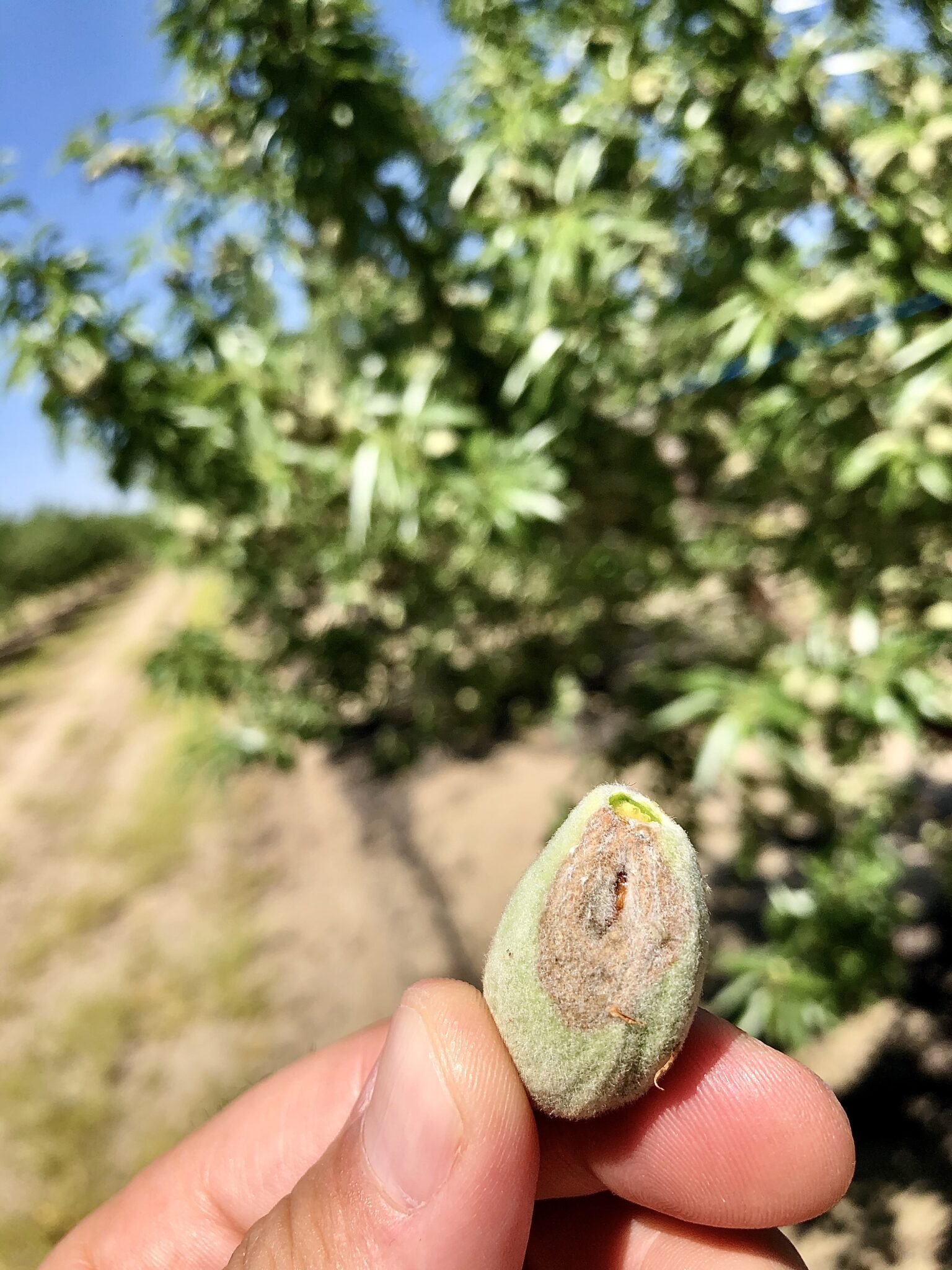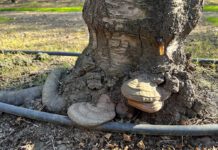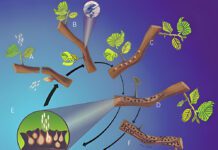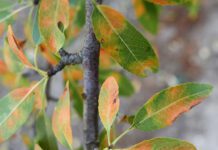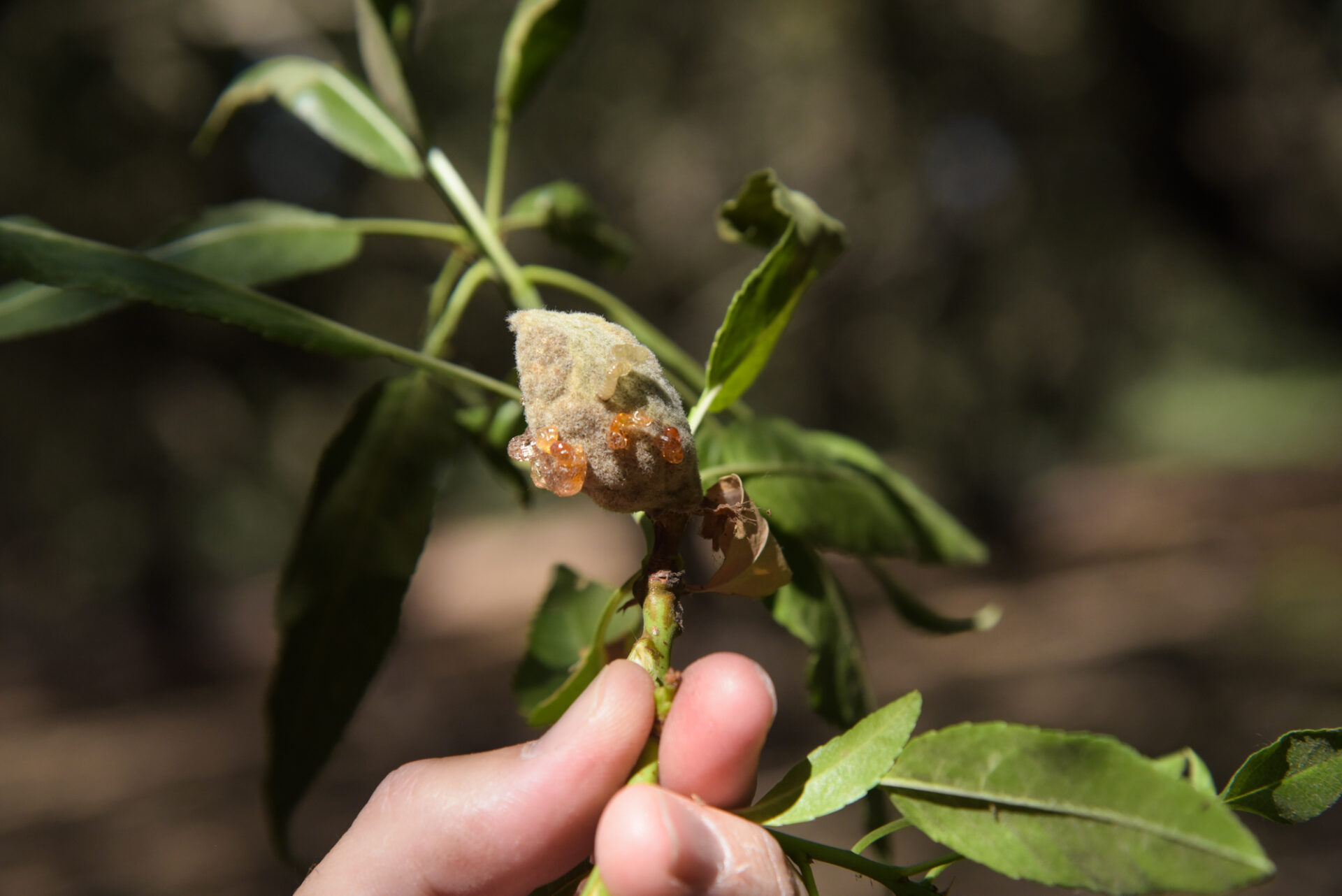
When it comes to managing diseases in almonds, watching the weather can be as important as watching your crop. Especially in the spring, when diseases like brown rot blossom blight, jacket rot, anthracnose and bacterial blast threaten crop health, it is often the weather that determines disease pressure.
“Watching the forecast is critical when it comes to control for all spring diseases,” said Florent Trouillas, UCCE Assistant Extension Specialist in plant pathology.
In a typical year, brown rot blossom blight, caused by the fungus Monilinia laxa, is the most prominent disease at bloom. It is an outlier of sorts in that it is favored by rainfall but can thrive even in years of low rainfall, according to Jim Adaskaveg, UC Riverside professor and plant pathologist.
“A lot of the new varieties are highly susceptible to brown rot, and it doesn’t need much in the way of rain,” Adaskaveg said. “It needs some moisture, but spores are windblown, and there is always moisture down in the basal cup of the flower.”
Other diseases, however, are very environmentally specific, Adaskaveg said.
Watch the Weather
“With the other diseases, like jacket rot, you have to have the right conditions,” he said. “You have to have a really good fruit set, and if it is wet and cool, you can get jacket rot. If you do not have all of those conditions, you will not see jacket rot.”
And the same with anthracnose,” Adaskaveg continued. “If you are getting two, three inches of rain during fruit development, then most likely you are going to have anthracnose on several of the major varieties like Monterey and Carmel. It is very environmentally specific to high rainfall conditions. And warmer temperatures are more conducive [to anthracnose development] than cooler temperatures.”
He added: “If you are getting high rainfall, you should be spraying for anthracnose.” If the disease gets a foothold, it can get into the wood of a tree and cause dieback. At that point, growers need to prune it out in the offseason, he said.
“If you don’t prune it out, it will come back to haunt you year after year,” Adaskaveg said.
Cooler than normal conditions at bloom in recent years have led to higher than normal pressure from bacterial blast, a disease that favors frosty temperatures, according to Trouillas, who is based at the Kearney Agricultural Research and Extension Center in Parlier.
In addition to liking cold temperatures, bacterial blast’s causal agent, Pseudomanas syringae, is very host-specific, Adaskaveg said. “We see it a lot on the newer varieties, the self-pollinating varieties,” he said. “We hardly see it on Nonpareil, for example, and some of the older, traditional varieties.”
Shot hole is another disease that needs rainfall and/or prolonged periods of wetness to flourish, Adaskaveg said. It hasn’t been much of an issue over the past decade or longer, however, in large part because fungicides used to control other diseases have kept it at bay, he said.
“We haven’t seen a major epidemic of shot hole in many years,” he said.
Once an orchard gets past the early leaf stage and early developing fruit stage, shot hole isn’t a threat to current year yields, he added. “At that point, it becomes a cosmetic problem, and it is an indication of what could happen next year with increased inoculum present on the tree, but it rarely causes crop loss once you get into April or May.”
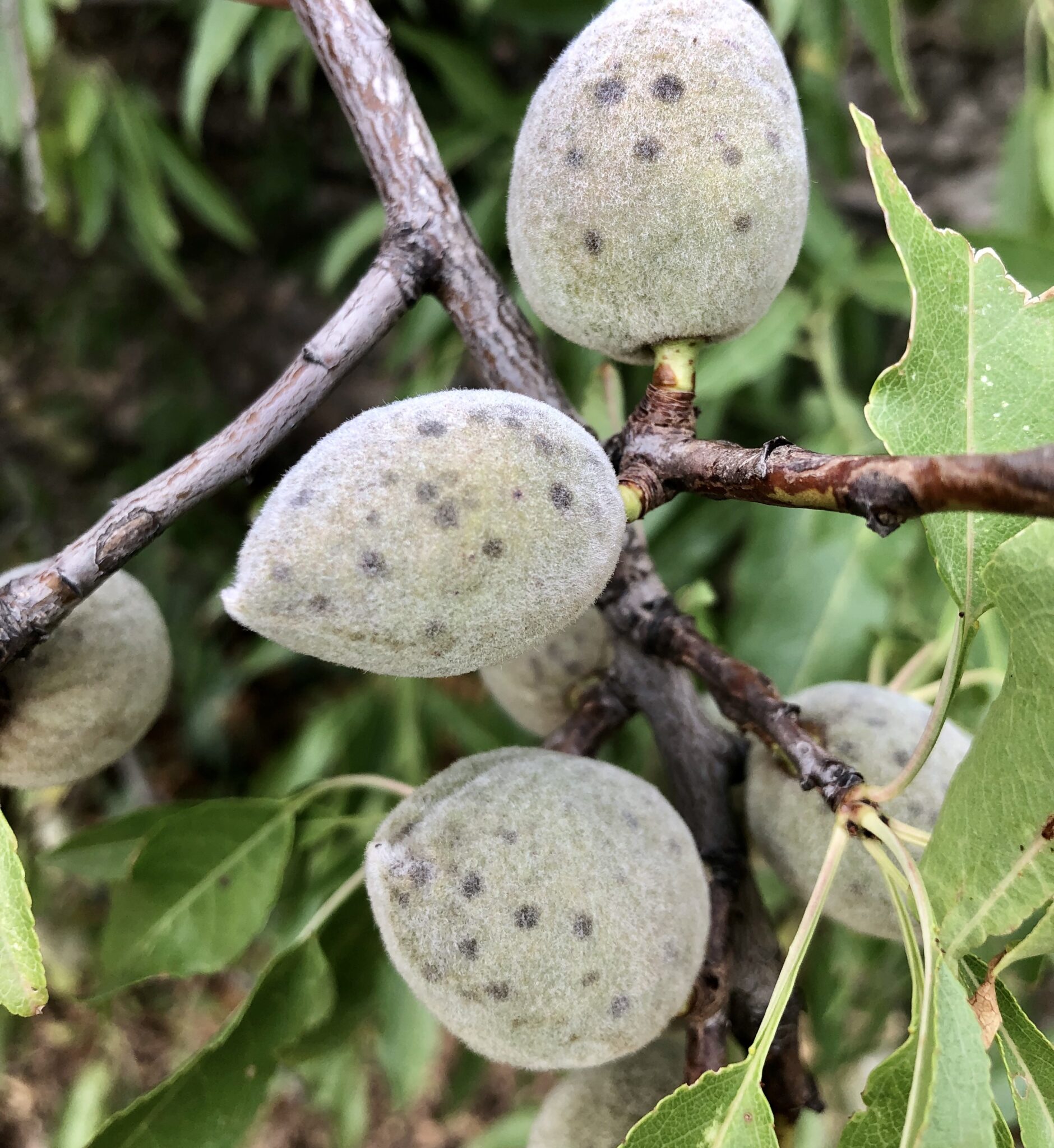
Scouting for Disease
When scouting for spring diseases, growers and PCAs should take into account the history of an orchard, and particularly disease pressure the previous year, plant pathologists said.
“If you have a history of disease, then you have to prepare for the season knowing your risk,” Trouillas said.
“You have to break it down into what diseases are affecting your orchard and in what location,” Adaskaveg said. “Your PCA or the grower who has a PCA license and some training can identify these diseases from the previous year. You look for symptoms and see what diseases you have at low levels, and those are the ones I would be concerned with the following year.”
Jacket rot symptoms, which include water-soaked brown spots on petals, will show up at the latter part of the bloom period, according to the UC Statewide IPM Program website. Trouillas recommends growers treat orchards at full bloom for jacket rot if conditions are conducive to disease development. Growers should consider continuing treatment until rains cease, especially when there is substantial fruit set and senescent flower parts are caught amongst the developing fruit.
Trees infected with brown rot blossom blight will have flowers that are blighted or rotting. Also, the brown rot pathogen, Monilinia laxa, can move beyond the flower into young shoots and twigs and cause a canker.
Flowers can become infected from pink bud to petal fall and are most susceptible when fully open, according to the IPM website.
In most years, one fungicide application at 80% bloom is sufficient to control the disease, Trouillas said. In years of extended bloom accompanied by rainfall, an application at pink bud may be needed, as well.
Cultivars very susceptible to brown rot include Drake, Winters and Wood Colony, Butte, Carmel and NePlus Ultra, according to the IPM site.
Flowers infected with anthracnose look similar to flowers infected with brown rot, according to the website. To better identify it, look for leaves on infected spurs that have developed marginal necrosis, beginning with water-soaked areas that fade in color. Dead leaves will remain attached to branches. Infected nuts show round, orangish, sunken lesions on the hulls, symptoms that may appear about three weeks after petal fall.
When treating for the disease, Trouillas advised growers to do so at full bloom and to continue treating for up to five weeks after petal fall if conditions are conducive to anthracnose development. High rainfall in May coupled with warm temperatures can also cause anthracnose epidemics.
Shot hole appears as spots on leaves, fruit, twigs and flowers, according to the IPM website. Growers can monitor orchards in the fall and spring for the presence of shot hole by looking for the presence of fruiting structures in shoots and leaves. Fruiting structures appear in the center of leaf lesions as small black spots and can be seen with a hand lens.
Bacterial blast symptoms include burnt-looking flowers, Trouillas said. For treatment, Trouillas recommends growers consider applying the bactericide kasugamycin, or Kasumin, the week prior to a forecast of cold and freezing temperatures at bloom.
Finding the Right Fungicide
In general, controlling diseases in almonds is not for the faint of heart. A full 26 diseases are discussed on the IPM website, with treatment timings spanning from the dormant season through June.
“There are many spring diseases,” Trouillas said. “The challenge is to have products that have efficacy for a wide diversity of pathogens and to get them on in the proper timing.”
When treating for the diseases, Trouillas and Adaskaveg encouraged growers to rotate chemistries and use premixtures when possible.
“I like premixtures, such as a DMI with one of the other groups, like an SDHI or a QoI,” Adaskaveg said.
“The QoI fungicides are very good on shot hole as a group,” he said. “And all the DMIs and SDHIs are very good on brown rot. So, if you have a mixture of those compounds, you are going to get brown rot and you are going to get shot hole and even anthracnose.”
Also, he said, keeping spray numbers down can help slow the buildup of resistance. “In California, we are trying to keep our total sprays at four or five a season,” he said.
As for post-bloom sprays, Adaskaveg said he prefers a fungicide with broad spectrum activity. “During the petal-fall period, I would use a broad-spectrum material like chlorothalonil, (tradename Bravo or Echo),” he said. “It is registered with a long PHI (preharvest interval), but it can be used in early spring. It works on anthracnose, it works on shot hole, and it has some botrytis (or jacket rot) activity.”
